What makes a problem-solution essay successful?

This is the second of three chapters about Problem-Solution Essays. To complete this reader, read each chapter carefully and then unlock and complete our materials to check your understanding.
– Review the concepts of problem-solution essays
– Explore six steps for writing successful problem-solution essays
– Provide examples and language structures to help guide the reader
Before you begin reading...
-
video and audio texts
-
knowledge checks and quizzes
-
skills practices, tasks and assignments
Chapter 2

Having focussed more generally in Chapter 1 on the problem-solution essay type and its situations, problems, solutions, evaluations and questions, this second chapter on the subject next explores six steps for creating successful essays that highlight to the reader significant problems, credible solutions and effective evaluations. Follow these six steps carefully and your problem-solution essays should soon be rewarding you with better confidence and grades.
Step 1: Understand the Question
The first step to writing a successful problem-solution essay is to make sure you understand the essay question.
While students may occasionally be required to create the question for themselves, most of the time they will be provided with an essay question by their tutor or course handbook. As was explored in Chapter 1, there is a wide variety of language structures that may be used to introduce problem-solution essays, such as the following table shows:
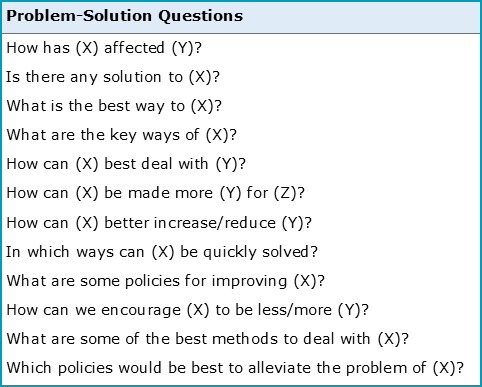
While there are many possible essay questions that you may encounter, for the remainder of this short reader we’ll be focusing on the following example question:

Clearly, this example question provides the situation ‘air pollution in developing countries’ for the writer, and asks that writer to (a) determine the problems created by this situation and (b) provide solutions for how these problems can be fixed. When writing your essay, make sure that you deconstruct the question in this way and follow its instructions very carefully – otherwise you may lose valuable marks.
Step 2: Plan and Research
Once you have your essay question, the next step will likely be to think of as many problems, solutions and evaluations as possible about the situation being explored. For our example essay about air pollution in developing countries, such a brainstorm might look something like the following:
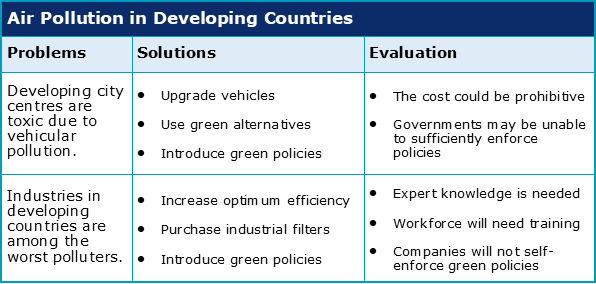
Once you’ve created a list such as the above, it’s important that you next look for source-based evidence that supports these main ideas. Don’t forget to make sure when finding academic sources that the research you use is appropriate and relevant, and that you are selective of which sources and main ideas you include. Focussing specifically on the solutions you provide in your essay, it’s important to make sure that each of these solutions is convincing, feasible, relevant to the problem in hand, and is supported with academic sources. To help you with making these decisions, we’ve listed twelve of the most common solutions below.
12 Common Solutions
1. Educate people about how to fix the problem.
2. Improve an existing solution that doesn’t work well enough.
3. Place a new leader in charge as the current one isn’t working.
4. Remove the person or thing that is the source of the problem.
5. Encourage people to help with a problem they know how to fix.
6. Create something new such as an organisation or piece of technology.
7. Instigate a compromise between the two parties creating the problem.
8. Better enforce the current laws that exist to help alleviate the problem.
9. Use a different procedure or method because the current way is inadequate.
10. Create new laws and policies because the existing laws do not fix the problem.
11. Provide more resources to fix the problem, such as money, equipment or people.
12. Change people’s attitudes because it is these attitudes that are causing the problem.
Step 3: Consider Your Overall Structure
The third step to crafting an effective problem-solution essay is to then think carefully about the overall structure. This means selecting which main ideas you’re going to include in your essay and then deciding whether you’re going to arrange those ideas into a block or chain structure. Block structures are generally considered to be more appropriate for shorter problem-solution essays in which the writer has a more limited number of problems to explore. As is shown in the diagram below, a block structure is when the problems and solutions are discussed in separate blocks, otherwise known as paragraphs:
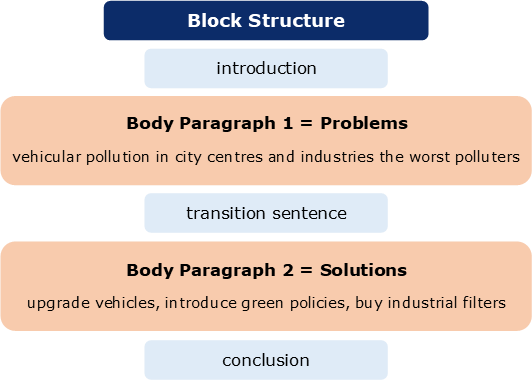
Chain structures, on the other hand, are useful when the writer wishes to discuss the problem and its related solutions within the same paragraph:
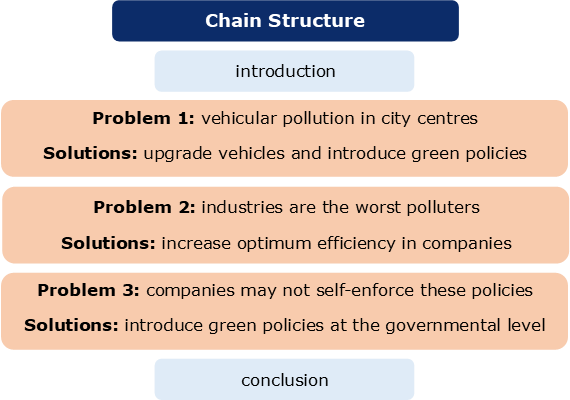
Remember that in both of these structures, it is up to the writer to decide whether they wish to include the evaluations of each solution within the body section of their essay or within their conclusion.
Step 4: Include Essay Elements
Another way of guaranteeing the successful creation of a problem-solution essay is to make sure that you include many of the following elements:
Opening Sentences
“Air is typically defined as being polluted when an excess of gases, particles and compounds are detected in the Earth’s atmosphere at levels that cause harm to human life and the Earth’s ecosystems.”
“Not only are gases such as carbon monoxide and nitrogen oxide likely responsible for climate change, but when combined with other pollutants such as volatile organic compounds (VOCs), air pollution may account for approximately seven million premature deaths annually (Smith, 2018).”
“Focusing on emissions from transportation and industry, this essay explores the key technological and political polices that could be implemented to help resolve the current global air pollution crisis.”
“As a result of fewer regulations in fuel and vehicle quality and significantly higher populations, many Asian city centres have now become toxic to human health (Williams, 2018).”
“Since 2002, Delhi, Dhaka and Beijing have all reportedly seen mortality rates from lung cancer double even though the amount of cigarette smokers has in fact declined (Yuang, 2012).”
“This essay highlights how the problem of air pollution has shifted in recent years from the more economically stable regions to those that are still growing.”
“Essentially, it has been argued in this paper that a top down approach is required in developing countries.”
Future Considerations
“Short-term losses should perhaps be considered against the value of life and the basic human right to breath clean air.”
Step 5: Include Appropriate Language
There are also particular language structures that students should try to include in their essay when providing solutions to problems and when providing evaluations to solutions. While cohesive devices and transition markers such as ‘first’ or ‘however’ might be useful in any essay, the following language is particularly relevant to problem-solution essay types:
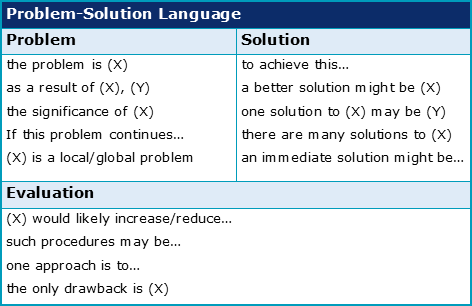
After completing Chapter 2 and its activities, continue on to Chapter 3 to see many of these language structures highlighted in the example problem-solution essay.
Step 6: Edit and Proofread
Finally, and as with all essays, a good writer should always look carefully during the editing and proofreading stages for any elements that can be improved. This means paying careful attention to subject-specific vocabulary, academic and unacademic language, spelling mistakes, grammar errors and problems with sentence structures. For the more content-based details such as main ideas and supporting ideas, a successful writer should not be afraid of deleting or rewriting large sections of text in an attempt to improve that text – and you shouldn’t be too.
Having now discussed the six most important steps for creating effective problem-solution essays, continue on to Chapter 3 if you wish to read our example. Don’t forget also to complete the Chapter 2 activities to check your understanding.
To reference this reader:
Academic Marker (2022) Problem-Solution Essays. Available at: https://academicmarker.com/essay-writing/essay-types/problem-solution-essays/ (Accessed: Date Month Year).
Downloadables
Once you’ve completed all three chapters in this short reader about Problem-Solution Essays, you might then wish to download our Chapter Worksheets to check your progress or print for your students. These professional PDF worksheets can be easily accessed for only a few Academic Marks.
Chapter 1 explores the topic: What is an academic problem-solution essay? Our Chapter 1 Worksheet (containing guidance, activities and answer keys) can be accessed here at the click of a button.
Chapter 2 explores the topic: What makes a problem-solution essay successful? Our Chapter 2 Worksheet (containing guidance, activities and answer keys) can be accessed here at the click of a button.
Chapter 3 explores the topic: What is an example problem-solution essay? Our Chapter 3 Worksheet (containing guidance, activities and answer keys) can be accessed here at the click of a button.
To save yourself 2 Marks, click on the button below to gain unlimited access to all of our Problem-Solution Essays Chapter Worksheets. This All-in-1 Pack includes every chapter, activity and answer key related this topic in one handy and professional PDF.
Collect Academic Marks
-
100 Marks for joining
-
25 Marks for daily e-learning
-
100-200 for feedback/testimonials
-
100-500 for referring your colleages/friends